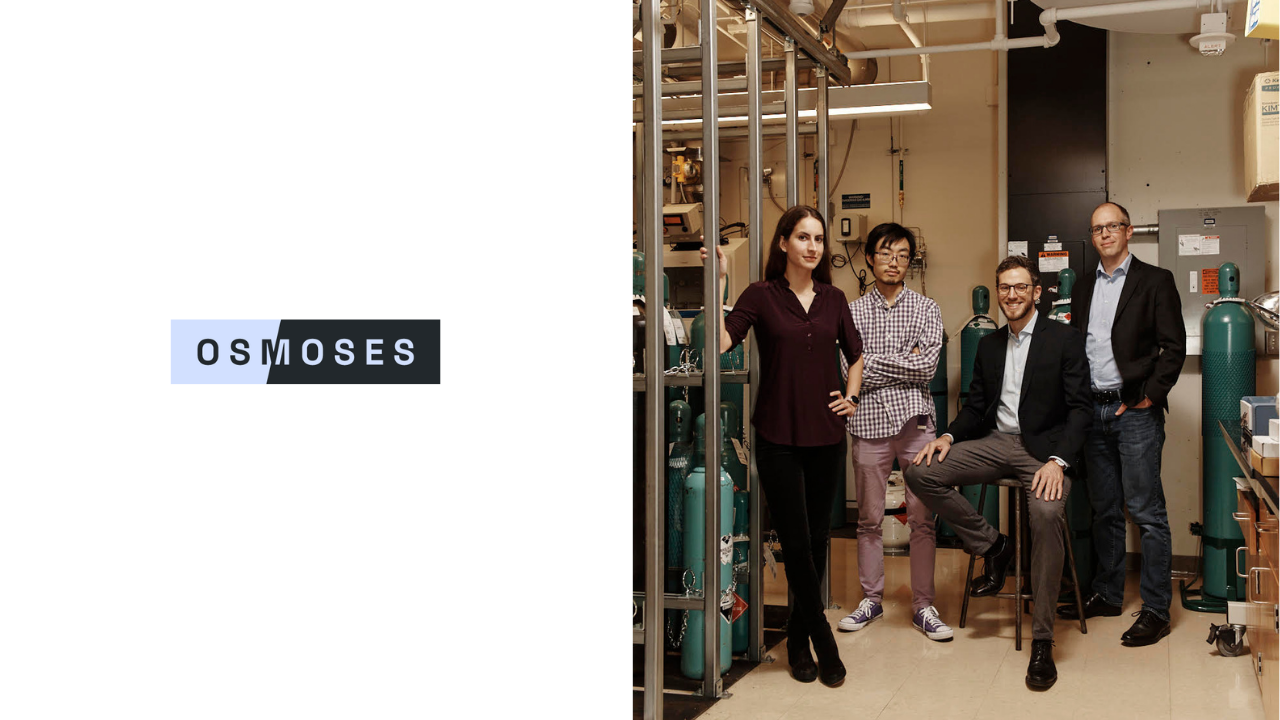Osmoses (2021 Cleantech Open Northeast Regional Winner and the Winner of the 2021 Cleantech Open Northeast Carbon Sequestration/CCUS Prize, Apply to the 2022 Carbon Sequestration/CCUS Prize), founded by CEO Francesco Benedetti and CTO Holden Lai, is working on scaling and marketing molecular membranes to reduce energy and resource use in the industrial chemical industry. This is an important technology because it allows large-scale, energy-intensive processes to be replaced by a membrane that is less space, energy, and capital intensive, providing a myriad of environmental and economic benefits.
Industrial Chemical Separations are Outdated
The chemical and energy industries produce products in mixtures.
To arrive at the final product, there needs to be a purification step to separate mixtures into components.
For example, in modern carbon capture, CO₂ is removed from flue gas, which is a mixture of CO₂, nitrogen, sulfur oxides, and nitrogen oxides.
The chemical industry currently relies on distillation and absorption unit operations to make products and remove impurities.
- Distillation is the process of separating liquid mixtures based on boiling point. Essentially, it uses heat to turn one molecule into vapor while the other stays a liquid.
- Distillation is responsible for 40% of greenhouse gas emissions in the chemical industry.
- Adsorption involves some sort of adhesion medium in a column. While this can take many, many forms, for our purposes think of a column full of beads that attracts a molecule you want to remove. Adsorption requires a liquid wash or high temperature and pressure to then separate the molecule and the adsorbent.
- The cost here is highly variable, as it depends on what/how one is separating the mixture.
Operating these processes at scale requires massive pieces of equipment, which means significant capital is required.
According to Osmoses, “15% of the world’s energy and carbon output is wasted on inefficient chemical separations.” The challenge, then, to solve is finding a better way to separate these chemical mixtures.
Where Membranes Come In
Osmoses has developed a novel polymer membrane that acts as a passive barrier to separate chemicals based on size, rather than boiling point or chemical charge.
For example, if there’s a mixture of hydrogen and methane, the membrane would selectively allow hydrogen to go through while leaving methane behind, no heating or wash chemical needed. Osmoses’ current membrane can effectively separate gas molecules between 2.9 and 4 angstroms, which covers the smallest gas molecules with some of the biggest markets, including hydrogen, methane, carbon dioxide, oxygen, and nitrogen.
Osmoses’ Journey From Idea to Company
Osmoses is no stranger to accelerators. They have gone through several programs including NSF I-Corps, the MIT $100k (sounds like an ultramarathon, it is not, although I would totally sign up for that), the Activate Fellowship, and Cleantech Open. Each one provided the knowledge, connections, and tools to build the company piece by piece. Their current market strategy and business model has come from moving through each one of these programs, working with business, start-up, and finance leaders, and figuring out how to best bring their product to market.
Outlook
Simply put, Osmoses is innovating outdated industrial processes. Francesco and Holden have been doing their due diligence in order to build a viable company from an MIT-based PhD project. They have a technology that meets an unmet market need, namely low cost, efficient gas separation that eschews the traditional resource and equipment intensive processes. If they can effectively scale and install their membranes, it would be a huge win for companies and the environment.
About The Author

John currently works at the Pacific Northwest National Laboratory as an Engineering Analyst Fellow. He has his master’s in Biotechnology, Sustainability, and Entrepreneurship from Northwestern University and has conducted research on microbial wastewater mitigation, soil batteries, and biomass chemical conversion and valorization. His goal is to help the world develop, understand, and embrace solutions to the climate crises. In his spare time he enjoys trail running, cycling, rock climbing, reading books, and playing the banjo.

